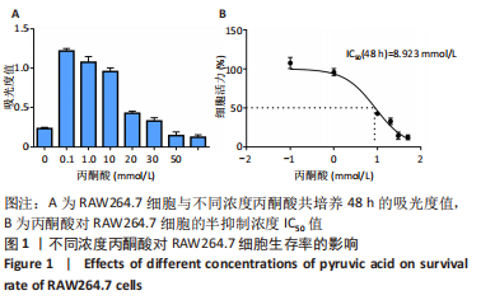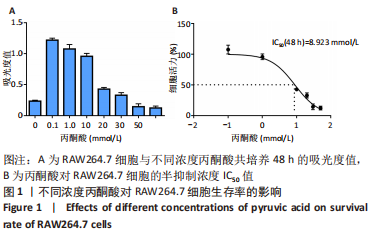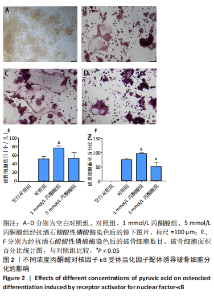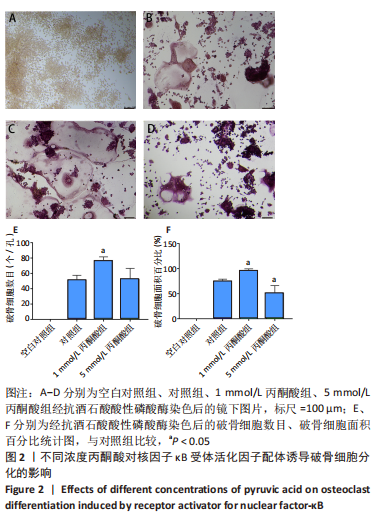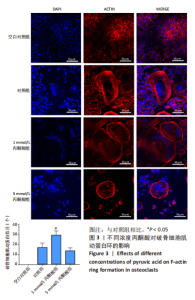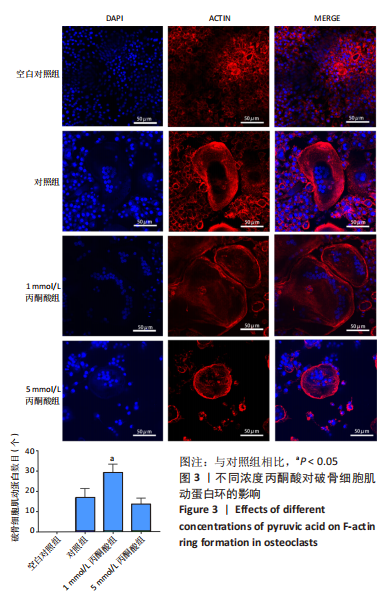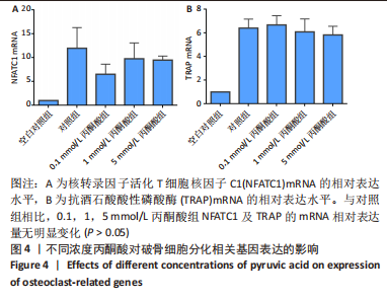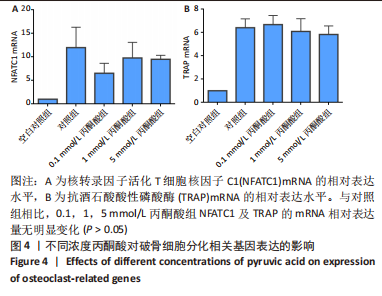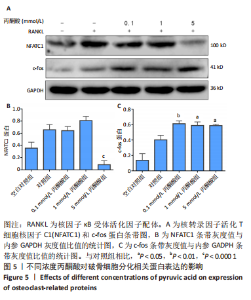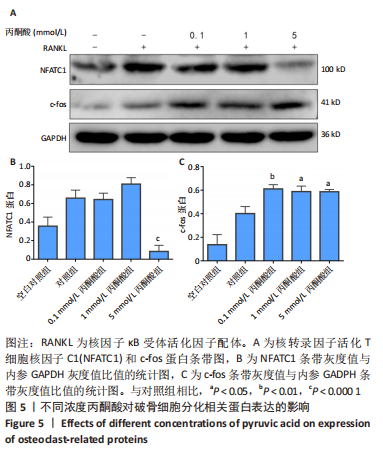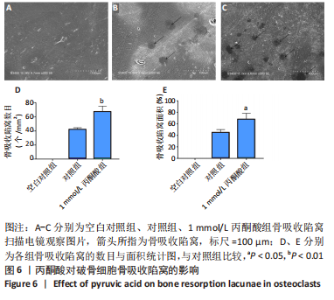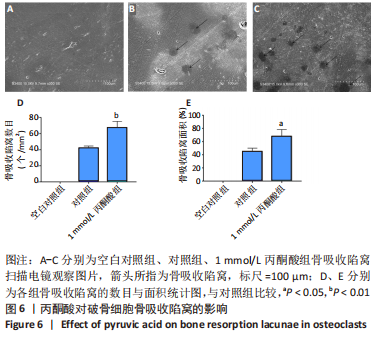Chinese Journal of Tissue Engineering Research ›› 2023, Vol. 27 ›› Issue (31): 5015-5021.doi: 10.12307/2023.584
Previous Articles Next Articles
Role of pyruvic acid in osteoclast differentiation
Liu Guanjuan1, Xia Qianxi1, Song Na1, Huo Hua1, Hong Wei2, Liao Jian1
- 1School of Stomatology/Stomatological Hospital of Guizhou Medical University, Guiyang 550004, Guizhou Province, China; 2Key Laboratory of Molecular Biology, Guizhou Medical University, Guiyang 550004, Guizhou Province, China
-
Received:2022-08-24Accepted:2022-10-12Online:2023-11-08Published:2023-01-31 -
Contact:Liao Jian, MD, Professor, Chief physician, Doctoral/Master’s supervisor, School of Stomatology/Stomatological Hospital of Guizhou Medical University, Guiyang 550004, Guizhou Province, China -
About author:Liu Guanjuan, Master candidate, School of Stomotology/Stomotological Hospital of Guizhou Medical University, Guiyang 550004, Guizhou Province, China Xia Qianxi, School of Stomatology/Stomatological Hospital of Guizhou Medical University, Guiyang 550004, Guizhou Province, China -
Supported by:National Natural Science Foundation of China, No. 82060207 (to LJ); Science and Technology Foundation of Guizhou Provincial Health Commission, No. gzwkj2022-165 (to LJ); College Student Innovation and Entrepreneurship Training Project, No. 202110660022 (to XQX and LJ)
CLC Number:
Cite this article
Liu Guanjuan, Xia Qianxi, Song Na, Huo Hua, Hong Wei, Liao Jian. Role of pyruvic acid in osteoclast differentiation[J]. Chinese Journal of Tissue Engineering Research, 2023, 27(31): 5015-5021.
share this article
Add to citation manager EndNote|Reference Manager|ProCite|BibTeX|RefWorks
| [1] SUZUKI A, MINAMIDE M, IWAYA C, et al. Role of Metabolism in Bone Development and Homeostasis. Int J Mol Sci. 2020;21(23): 8992. [2] UDAGAWA N, KOIDE M, NAKAMURA M, et al. Osteoclast differentiation by RANKL and OPG signaling pathways. J Bone Miner Metab. 2021; 39(1):19-26. [3] IKEDA K, TAKESHITA S. The role of osteoclast differentiation and function in skeletal homeostasis. J Biochem. 2016;159(1):1-8. [4] LEMMA S, SBOARINA M, PORPORATO P E, et al. Energy metabolism in osteoclast formation and activity. Int J Biochem Cell Biol. 2016;79:168-180. [5] KANAZAWA I. Interaction between bone and glucose metabolism [Review]. Endocr J. 2017;64(11):1043-1053. [6] PARK-MIN KH. Metabolic reprogramming in osteoclasts. Semin Immunopathol. 2019;41(5):565-572. [7] KARNER CM, LONG F. Glucose metabolism in bone. Bone. 2018;115: 2-7. [8] LI B, LEE WC, SONG C, et al. Both aerobic glycolysis and mitochondrial respiration are required for osteoclast differentiation. Faseb J. 2020; 34(8):11058-11067. [9] 丛林,朱静华.丙酮酸盐的功效和使用[J].田径,2022(2):84. [10] 李敏,马凌云,陈超阳,等.丙酮酸钠药理学作用的研究现状[J].中国临床药理学杂志,2021,37(3):341-344. [11] LUO Z, ZENG W, DU G, et al. Enhancement of pyruvic acid production in Candida glabrata by engineering hypoxia-inducible factor 1. Bioresour Technol. 2020;295:122248. [12] KAO KK, FINK MP. The biochemical basis for the anti-inflammatory and cytoprotective actions of ethyl pyruvate and related compounds. Biochem Pharmacol. 2010;80(2):151-159. [13] FUKUSHIMA M, LEE SM, MORO N, et al. Metabolic and histologic effects of sodium pyruvate treatment in the rat after cortical contusion injury. J Neurotrauma. 2009;26(7):1095-1110. [14] INDO Y, TAKESHITA S, ISHII KA, et al. Metabolic regulation of osteoclast differentiation and function. J Bone Miner Res. 2013;28(11): 2392-2399. [15] 王银博,孙维佳,李玉恒,等.破骨细胞能量代谢的研究进展[J].中国骨质疏松杂志,2022,28(1):139-142. [16] MOTYL KJ, GUNTUR AR, CARVALHO AL, et al. Energy Metabolism of Bone. Toxicol Pathol. 2017;45(7):887-893. [17] 张晓丽.谷氨酸与丙酮酸对星形胶质细胞耐受氧化应激的影响[D].福州:福建医科大学,2021. [18] ZENG X, ZHANG Y, WANG S, et al. Artesunate suppresses RANKL-induced osteoclastogenesis through inhibition of PLCγ1-Ca(2+)-NFATc1 signaling pathway and prevents ovariectomy-induced bone loss. Biochem Pharmacol. 2017;124: 57-68. [19] ASAGIRI M, SATO K, USAMI T, et al. Autoamplification of NFATc1 expression determines its essential role in bone homeostasis. J Exp Med. 2005;202(9):1261-1269. [20] CHEN Z, DING M, CHO E, et al. 2-NPPA Mitigates Osteoclastogenesis via Reducing TRAF6-Mediated c-fos Expression. Front Pharmacol. 2020;11:599081. [21] BAEK JM, KIM JY, LEE CH, et al. Methyl Gallate Inhibits Osteoclast Formation and Function by Suppressing Akt and Btk-PLCγ2-Ca(2+) Signaling and Prevents Lipopolysaccharide-Induced Bone Loss. Int J Mol Sci. 2017;18(3): 581. [22] ASAGIRI M, TAKAYANAGI H. The molecular understanding of osteoclast differentiation. Bone. 2007;40(2):251264. [23] 王瀚,曹新生,张舒.破骨细胞体外培养技术[J].中国骨质疏松杂志,2014,20(11):1284-1289. [24] AHN H, LEE K, KIM JM, et al. Accelerated Lactate Dehydrogenase Activity Potentiates Osteoclastogenesis via NFATc1 Signaling. PLoS One. 2016;11(4):e0153886. [25] TIEDEMANN K, LE NIHOUANNEN D, FONG JE, et al. Regulation of Osteoclast Growth and Fusion by mTOR/raptor and mTOR/rictor/Akt. Front Cell Dev Biol. 2017;5(18):54. [26] KOH-BANERJEE PK, FERREIRA MP, GREENWOOD M, et al. Effects of calcium pyruvate supplementation during training on body composition, exercise capacity, and metabolic responses to exercise. Nutrition. 2005;21(3):312-319. [27] HU S, MA L, LUO HM, et al. Pyruvate is superior to reverse visceral hypoperfusion in peritoneal resuscitation from hemorrhagic shock in rats. Shock. 2014;41(4):355-361. [28] HIDVéGI M. Inhaled Nebulized Sodium Pyruvate Use in COVID-19 Patients. Isr Med Assoc J. 2020;22(5):278. [29] 刘翔宇,柴家科,刘甜,等.口服丙酮酸钙盐糖液对重度烧伤大鼠伤后早期氧合脏器功能及生存率的影响[J].解放军医学院学报, 2021,42(8):836-842+856. [30] LI Y, CHEN J, LUN SY. Biotechnological production of pyruvic acid. Appl Microbiol Biotechnol. 2001;57(4):451-459. [31] LUO B, ZHOU X, TANG Q, et al. Circadian rhythms affect bone reconstruction by regulating bone energy metabolism. J Transl Med. 2021;19(1):410. [32] ZHANG HY, TAN XX, KANG K, et al. Simultaneous determination of lactic acid and pyruvic acid in tissue and cell culture media by gas chromatography after in situ derivatization-ultrasound-assisted emulsification microextraction. Anal Bioanal Chem. 2019;411(3):787-795. [33] KIM JM, JEONG D, KANG HK, et al. Osteoclast precursors display dynamic metabolic shifts toward accelerated glucose metabolism at an early stage of RANKL-stimulated osteoclast differentiation. Cell Physiol Biochem. 2007;20(6):935-946. [34] 林璐,顾玉婷,陆尔奕.糖酵解与骨代谢关系的研究进展[J].口腔材料器械杂志,2020,29(3):168-172+180. [35] FONG JE, LE NIHOUANNEN D, TIEDEMANN K, et al. Moderate excess of pyruvate augments osteoclastogenesis. Biol Open. 2013;2(4):387-395. [36] SONG C, YANG X, LEI Y, et al. Evaluation of efficacy on RANKL induced osteoclast from RAW264.7 cells. J Cell Physiol. 2019;234(7): 11969-11975. [37] TAKAYANAGI H. RANKL as the master regulator of osteoclast differentiation. J Bone Miner Metab. 2021;39(1):13-18. [38] KODAMA J, KAITO T. Osteoclast Multinucleation: Review of Current Literature. Int J Mol Sci. 2020;21(16):5685. [39] TAKAYANAGI H, KIM S, KOGA T, et al. Induction and activation of the transcription factor NFATc1 (NFAT2) integrate RANKL signaling in terminal differentiation of osteoclasts. Dev Cell. 2002;3(6):889-901. [40] SHI Y. The investigation of energy metabolism in osteoblasts and osteoclasts. Hua Xi Kou Qiang Yi Xue Za Zhi. 2021;39(5):501-509. [41] JIN Z, KHO J, DAWSON B, et al. Nitric oxide modulates bone anabolism through regulation of osteoblast glycolysis and differentiation. J Clin Invest. 2021;131(5):e138935. [42] WANG Y, VAN ASSEN A HG, REIS CR, et al. Novel RANKL DE-loop mutants antagonize RANK-mediated osteoclastogenesis. Febs J. 2017; 284(15):2501-2512. [43] XIXI Z, QIAN P, WANG B. Electrolyzing lactic acid in situ in fermentation broth to produce pyruvic acid in electrolysis cell. Appl Microbiol Biotechnol. 2019;103(10):4045-4052. [44] GRAY LR, TOMPKINS SC,TAYLOR EB. Regulation of pyruvate metabolism and human disease. Cell Mol Life Sci. 2014;71(14):2577-2604. [45] ŽIŽKOVá R, HEDVIČáKOVá V, BLAHNOVá VH, et al. The Effect of Osteoblast Isolation Methods from Adult Rats on Osteoclastogenesis in Co-Cultures. Int J Mol Sci. 2022;23(14):7875. |
| [1] | Dang Yi, Du Chengyan, Yao Honglin, Yuan Nenghua, Cao Jin, Xiong Shan, Zhang Dingmei, Wang Xin. Hormonal osteonecrosis and oxidative stress [J]. Chinese Journal of Tissue Engineering Research, 2023, 27(9): 1469-1476. |
| [2] | Sun Jiajia, Zhu Haidi, Lu Yun, Zhang Kai. Comparison of bone metabolism markers between type 2 diabetes mellitus and non-type 2 diabetes mellitus patients with hip fracture [J]. Chinese Journal of Tissue Engineering Research, 2023, 27(8): 1156-1160. |
| [3] | Long Guiyue, Li Dongdong, Liao Hongbing. Calcium phosphate cement/poly(lactic-co-glycolic acid) degradation products promote osteoclast differentiation of mouse monocytes [J]. Chinese Journal of Tissue Engineering Research, 2023, 27(8): 1193-1198. |
| [4] | Huang Linke, Wei Linhua, Jiang Jie, Liu Qian, Chen Weiwei. Effects of estrogen combined with treadmill exercise on bone mass and articular cartilage in ovariectomized mice [J]. Chinese Journal of Tissue Engineering Research, 2023, 27(8): 1166-1171. |
| [5] | Yang Zhishan, Tang Zhenglong. YAP/TAZ, a core factor of the Hippo signaling pathway, is involved in bone formation [J]. Chinese Journal of Tissue Engineering Research, 2023, 27(8): 1264-1271. |
| [6] | Shao Zichen, Li Huanan, Gu Bing, Zhang Xiaoyun, Sun Weikang, Liu Yongqian, Gan Bin. MicroRNA, long non-coding RNA and circular RNA mediate the mechanism of decreasing uric acid, anti-inflammation and regulating bone metabolism in gout [J]. Chinese Journal of Tissue Engineering Research, 2023, 27(5): 765-771. |
| [7] | Zhang Min, Zhang Xiaoming, Liu Tongbin. Application potential of naringin in bone tissue regeneration [J]. Chinese Journal of Tissue Engineering Research, 2023, 27(5): 787-792. |
| [8] | Liu Guanjuan, Song Na, Huo Hua, Luo Shanshan, Cheng Yuting, Xiong Yue, Hong Wei, Liao Jian. Zoledronic acid inhibits lipopolysaccharide-induced osteoclast differentiation by regulating NLRP3 signaling pathway [J]. Chinese Journal of Tissue Engineering Research, 2023, 27(29): 4677-4683. |
| [9] | Shen Mengran, Ren Yansong, Zhou Yu, Yue Debo, Ma Jinhui, Wang Bailiang. Interleukin-33-mediated bone immunity [J]. Chinese Journal of Tissue Engineering Research, 2023, 27(29): 4723-4728. |
| [10] | Wei Zongbo, Su Yunyu, Zhang Xiaoyun, Huang Wei, Xu Hang, Liu Rongfa. Role and mechanism by which long non-coding RNAs regulate subchondral bone homeostasis in knee osteoarthritis [J]. Chinese Journal of Tissue Engineering Research, 2023, 27(29): 4736-4744. |
| [11] | Zhang Bowen, Li Mei, Zhang Jinning, Yang Tianxiang, Cheng Mengqi, Chen Desheng. Tetrandrine inhibits osteoclast differentiation by inducing autophagy [J]. Chinese Journal of Tissue Engineering Research, 2023, 27(28): 4473-4479. |
| [12] | Su Hui, Yan Binghan, Wang Ruochong, Xue Haipeng, Tan Guoqing, Xu Zhanwang. Effect of Bushen Zhuanggu Fang on bone metabolism and bone mineral density in rats with ovariectomized osteoporosis [J]. Chinese Journal of Tissue Engineering Research, 2023, 27(28): 4507-4512. |
| [13] | Xiong Bo, Zeng Ping, Liu Jinfu, Lu Guanyu, Chen Cai, Huang Yue, Chen Lihua. Roles of N6-methyladenosine methyltransferase-like 3 in regulating bone metabolism and related diseases [J]. Chinese Journal of Tissue Engineering Research, 2023, 27(28): 4566-4570. |
| [14] | Song Jianhui, Mu Jihong, Li Shiwen. miR-23b effects on transforming growth factor beta1 and osteoclast activity in synovial tissue of rats with rheumatoid arthritis [J]. Chinese Journal of Tissue Engineering Research, 2023, 27(26): 4175-4180. |
| [15] | Han Xing, Li Wenwen, Ma Wensheng. Three-dimensional cultured periodontal ligament stem cells promote osteoclastic differentiation of RAW264.7 under static compression [J]. Chinese Journal of Tissue Engineering Research, 2023, 27(24): 3810-3817. |
| Viewed | ||||||
|
Full text |
|
|||||
|
Abstract |
|
|||||
